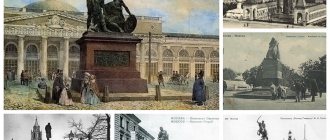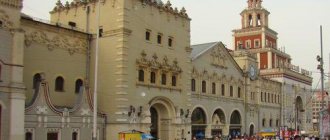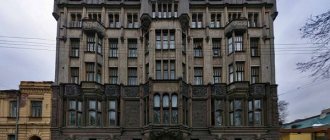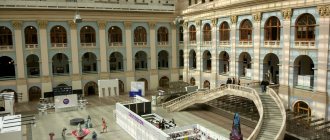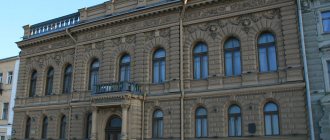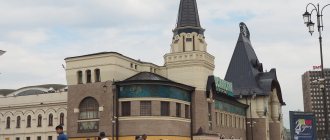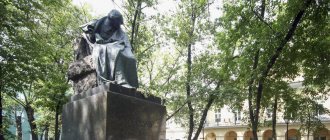Vitebsky railway station in St. Petersburg
Vitebsky railway station in St. Petersburg.
Photo: Natalya Volkova / photobank "Lori" Vitebsky station was the first in Russia - it was originally called Tsarskoselsky. In the 1830s, its building was wooden, then in the mid-19th century it was replaced by a stone structure. The modern station building, built in 1902–1904, is the work of architect Stanislav Brzozovsky and engineer Sima Minash. They designed a building in the Art Nouveau style, unusual for that time: previously only private mansions had been built in this way in St. Petersburg. The station was also innovative from a technical point of view: inside it there were transporters, elevators for luggage and passengers.
History of Moscow
In the middle of the 19th century, the famous Russian architect Konstantin Ton developed and implemented the design of the first Moscow railway station, and already in the first November days in 1851, the first train passed between the northern capital and Moscow.
The architect, as for most of his famous buildings, used the so-called Russian-Byzantine style for the project. This solution is successfully combined with the details of other buildings of the Moscow-Petersburg Railway and looks harmonious with them as a single architectural composition.
The center of the station building overlooked Kalanchevskaya Square, and immediately behind the main structure there were rails and platforms from which trains departed and arrived. This part of the complex was hidden behind an ultra-modern metal landing stage in those days. It was hidden from Kalanchevskaya Square by the station building itself. The central part of the structure had two floors, above which there was a clock tower, reminiscent in style of the tower above the St. Petersburg City Duma and having outlines similar to Western European town halls. The main building housed waiting rooms for rich passengers, and along the railway tracks there were rooms for people of lower social classes and a luggage compartment. Here, a separate room was allocated for passengers belonging to the imperial family. Four years after commissioning, in 1855, the railway and station began to be called Nikolaevsky in honor of the emperor. At the turn of two centuries and in the stormy winds of revolutionary change, the changes that other Moscow stations underwent almost did not affect Nikolaevsky. During this time, only minor reconstruction work and minor redevelopments slightly affected the entire building. The main changes were related only to the names. At the end of 1923, the station received the name Oktyabrsky, and in 1937 it was renamed Leningradsky, as it is known to this day.
Leningradsky Station on Soviet postcards A serious reconstruction of the entire complex was carried out only in Soviet times. In 1974, instead of a landing stage, a large passenger hall, premises for ticket offices and other purposes were built. But that part of the building that faces Kalanchevskaya Square was left practically untouched.
Modern times. Leningradsky Station Before reconstruction
Modern times. Leningradsky Station After reconstruction It is interesting that today, like almost one hundred and fifty years ago, this building is under the control of the Leningrad, and not the Moscow Railway, and is on its balance sheet.
Leningradsky railway station in Moscow and Moskovsky railway station in St. Petersburg
Leningradsky railway station in Moscow. Photo: Oksana Aleshina / photobank “Lori”
Moskovsky railway station in St. Petersburg. Photo: Alexander Shchepin / photobank “Lori”
Also read about other architectural copies
The first Russian railway stations after Tsarskoye Selo were two twin buildings - in Moscow and St. Petersburg. They were designed by architect Konstantin Ton. Both stations were designed in the neo-Renaissance style: in the center of each of them there was a two-tier turret, and the facades were decorated with large Venetian windows. The inside of the building was also identical: on the ground floor there were lobbies, waiting rooms and imperial apartments, on the second there were service apartments for railway employees. The station in St. Petersburg opened in 1847, and in Moscow two years later.
Moscow train stations
All Moscow stations
Kazan Station
It was built according to the design of the architect A.V. Shchusev, author of the Moscow Hotel and the Mausoleum on Red Square. Shchusev applied the ancient Russian “mansion” principle of combining different volumes. The result was a building that some passengers had sometimes mistaken for the Kremlin. The calling card of the station is the corner tower, reminiscent of the Syuyumbike tower of the Kazan Kremlin. On its spire sits the dragon-like creature Zilant, the symbol of old Kazan. You can also see a clock with zodiac signs on the building. N.K. participated in the creation of the interiors of the Kazansky station. Roerich, A.N. Benoit, B.M. Kustodiev, E.E. Lansere. The station was built from 1913 to 1948. He is the youngest, but one of the largest in Moscow.
Only at the Kazansky station do trains approach the platform in an unusual way, on the left side. The fact is that the line to Ryazan was designed and built together with English engineers back in 1862. And they are more accustomed to driving on the left. It turned out to be too expensive to redo everything, so they left it that way.
Kazansky station schedule
Kursky railway station
It combines the Kursk and former Nizhny Novgorod stations. They “came together” under one roof in 1896, when, according to the design of architect N. Orlov, an elegant building with white columns appeared on the Garden Ring. Until now, the station has different exits to the platforms of the Kursk and Gorky directions. In the 70s, the station acquired a modern look: a 200-meter building with a large glass facade, reminiscent of an airline terminal, was built. During the day there is almost always sun inside the halls, and in the evening the “sun” comes from the windows of the station itself, illuminating the entire station area. The large roof canopy imitates the canopy of the platform, and the folded roof itself hints at the rhythm of the train.
Kursky, unlike many Moscow stations, is not a dead-end station, but a transit one. From here it is equally easy to go to Anapa or St. Petersburg. This is one of the largest train stations in Moscow, which recently underwent reconstruction. In the above-ground part there are waiting rooms and ticket offices, in the underground there are storage rooms, exits to the platform and a passage to the metro.
Kursk station schedule
Leningrad Station
The station appeared in Moscow as the very first one, in 1849. And at first it was called Nikolaevsky, like its twin brother in St. Petersburg. Both stations were designed by architect K.A. In the same tone that built the Grand Kremlin Palace. The interiors of the station were also royally luxurious, because it repeatedly met the imperial families. After the revolution, the station began to be called Oktyabrsky, then Leningradsky. In 1977 and 2013, the station underwent two reconstructions, expanded, and began to cope with a large flow of passengers. The historical facade facing Komsomolskaya Square remained the same after all the reconstructions.
This is the only station in Moscow that is still subordinate not to the Moscow Railway, but to Oktyabrskaya, that is, St. Petersburg. It is also an experimental station: technological innovations are often tested here. For example, it was from the Leningradsky station that the Sapsan high-speed train first departed on the Moscow-St. Petersburg route.
Leningradsky station schedule
Savelovsky station
This station connected Moscow with the northern regions. The idea of building the road was proposed by Savva Mamontov. The large waterway along the Volga ended in Rybinsk and it was necessary to arrange the delivery of a large number of goods to the capital from there. The construction was supervised by A. Sumarokov. On March 10, 1902, the new station, an elegant Art Nouveau building, was inaugurated. It was then called Butyrsky - after the area where it was located. At that time, “Butyrki” were small villages separated by copses and fields.
In 1987, the station was reconstructed and expanded almost twice. Trains ran from here to Rybinsk and Uglich. There was also a leisurely and very beautiful route from Savelovsky station to St. Petersburg via Sonkovo. And in the 90s, the station was almost closed, some long-distance trains were canceled, the rest were transferred to the neighboring Belorussky. Currently, only regional express and commuter trains operate from Savyolovsky Station.
Savyolovsky station schedule
Yaroslavsky railway station
It is considered one of the most beautiful in Russia. This is a real northern fairy tale, created in 1902-1904 by F.O. Shekhtel on the site of the old wooden station. The building combines the traditions of ancient Russian architecture and the Art Nouveau style.
Until 1955, the station was called Northern: from here the road goes to the White Sea, and to the Arctic Circle, and to Father Frost and the Snow Maiden. You can also go to the Far East. This is the largest among Moscow stations in terms of passenger traffic. More than 300 pairs of trains arrive and depart there every day, and 6.5 million people pass through it per month. And this is the very first station where electric trains appeared: in 1929, the Moscow-Mytishchi section was electrified.
Yaroslavsky station schedule
Paveletsky railway station
The station appeared at the end point of the Moscow-Pavelets line. The private Ryazan-Urals road connected 12 provinces of Russia, but had no access to Moscow. Therefore, it was decided to build a road from Moscow to the village of Pavelets in the Ryazan province. The united road supplied Moscow with flour, grain, cereals, oil products and other goods. And passengers first arrived along the Biryulyovo-Tsaritsyno connecting line to the Kursky station. This is how the Ryazan-Ural and Kursk roads agreed among themselves.
Finally, on September 1, 1900, its own station was opened. Officially it was called Saratovsky, but more often - the station on Zatsepa, and from 1941 - Paveletsky. The reconstruction carried out in 1980 increased the station's capacity by 4 times and the volume of premises by 6 times. At the same time, the appearance of the building was preserved.
Paveletsky station schedule
Belorussky railway station
Its history began in the 1860s when the Moscow-Smolensk line began to be built. And the station was then called Smolensky. Then Brest, Alexandrovsky, Belarusian-Baltic. Under the leadership of engineer Ivan Strukov, a remarkable building in the neoclassical style, with Empire and Gothic elements, was built in 1912. The unique appearance of the station still attracts filmmakers.
Pilots Valery Chkalov and Mikhail Gromov, North Pole explorers with Ivan Papanin, and many foreign delegations were met at the Belorussky station. In 1941, trains left for the front from here, and here the song “Holy War” was sounded for the first time. The station building has a Military Hall and a museum.
The station has always been well equipped technically. At the beginning of the 20th century, the first ticket vending machines appeared at the Belorussky railway station. In the train schedule of the Belorussky Station, the names of the cities Warsaw, Berlin, Paris, Nice are a familiar thing. This is Moscow’s “window to Europe” and a convenient transfer hub for passengers at Sheremetyevo Airport, where the Aeroexpress train runs.
Belorussky Station schedule
Kyiv railway station
The station is a monument to the Patriotic War of 1812. The first station, built in 1899 and then called Bryansk, was small, dark and uncomfortable. In the year of the 100th anniversary of the Battle of Borodino, they decided to build a new one.
The design of the building with elements of classicism and empire style was made by architect I.I. Rerberg. And engineer V.G. Shukhov, the one who built the famous TV tower on Shabolovka, came up with the idea of covering the huge platform hall with a glazed arched structure. The length of the pavilion is 321 meters, height – 30, width – 47. Until now, this project has no equal. The station is also famous for its clock tower as tall as a 17-story building. The building's interiors are painted in a 1812 theme.
Kievsky station schedule
Rizhsky railway station
This is a “relative” of the St. Petersburg Vitebsk station. They were designed by the same architect, S.A. Brzhozovsky, but due to lack of time, the construction was given to Yu.F. Dietrich. The station changed its name several times: Vindavsky, Baltiysky, Rzhevsky, and since 1946 - Rizhsky. The grand opening of the new station took place on September 11, 1901. The beautiful, solemn, neo-Russian-style station was considered the most convenient in Moscow at that time. And the most technically equipped: it had its own power plant to illuminate the platforms and halls.
The Moscow-Vindava road opened the way to the Baltic states, to ice-free sea ports. Today the flow of passengers at the station is not very large. But here is the Museum of Railway Transport.
Rizhsky Station schedule
Baltiysky railway station in St. Petersburg
Baltiysky railway station in St. Petersburg. Photo: Alexander Shchepin / photobank “Lori”
The suburban station, from which trains departed to Peterhof, appeared on the Obvodny Canal embankment in 1857. The railway itself was built with private funds from Baron Alexander Stieglitz, who hoped that the government would later be able to buy it. The station was designed by architect Alexander Krakau. The building was divided inside into three parts: in one there were ticket offices and luggage compartments, in the other there were premises for the imperial family, and in the third there was a hall for other passengers. The station was mainly used by St. Petersburg summer residents who went to the city suburbs for the summer.
New Peterhof station
New Peterhof station. Photo: Igor Litvyak / photobank “Lori”
The station building in Peterhof was built in 1855–1857 according to the design of the architect Nikolai Benois, who decided on its architectural appearance in the neo-Gothic style. On the western side there was a four-tiered tower with pointed arches and decorative spear-shaped pinnacle towers. The source of inspiration for Benoit was the cathedral in the Italian city of Orvieto: the architect had previously taken part in its restoration. On the façade of the station building was the coat of arms of Baron Alexander Stieglitz, the founder of the Peterhof Railway.
Yaroslavsky railway station in Moscow
Yaroslavsky railway station in Moscow. Photo: Denis Larkin / photobank “Lori”
The first building of the Yaroslavl station appeared in the middle of the 19th century. In 1895–1896, it was rebuilt according to the design of Lev Kekushev: he reconstructed the eastern wing of the building and the platform. The station acquired its modern appearance after reconstruction in 1902–1904 under the leadership of Fyodor Shekhtel. The architect designed the facade of the building in a neo-Russian style with Art Nouveau elements, decorating it with decorative plant patterns, images of northern animals and ceramic panels with the coats of arms of Moscow, Yaroslavl and Arkhangelsk. The interior of the building was complemented by picturesque panels by Mikhail Vrubel and Konstantin Korovin. When designing the station, Shekhtel was inspired by the architecture of the Moscow Kremlin and the Spassky Monastery in Yaroslavl.
Five historical railway stations in Russia
Leningradsky railway station in Moscow.
Photo: Andrey RYABTSEV
At the station, we usually have no time to look at the mosaics, stucco moldings and other architectural details. We look for which route the train departs from, hurry to the storage room, buy water magazines for the trip... But. There are many railway stations in Russia that are interesting in themselves - as historical and architectural monuments, as well as places where popular films were filmed.
Experts from the travel website OneTwoTrip have chosen the five most beautiful historical stations in the country. Study it - maybe it’s from there or there that you’ll go on vacation or a business trip!
LENINGRAD STATION, MOSCOW
The oldest train station in Moscow is located on Komsomolskaya Square (“Three Stations”) next to the Yaroslavsky and Kazansky railway stations. Construction of the building began in 1844, the first passengers departed from here on the St. Petersburg-Moscow Railway began in 1851. Since then, the station has been reconstructed several times and the interiors have been redone. At first the station was called Nikolaevsky, from 1923 to 1937 - Oktyabrsky.
From Leningradsky Station, trains leave for St. Petersburg (two thirds of all departures go there), Veliky Novgorod, Murmansk, Petrozavodsk, Pskov, Tallinn, Helsinki...
Films where you can see Leningradsky Station: “Sorcerers”, “Girl without an Address”, as well as the film “The Saint” with Val Kilmer.
VITEBSK STATION, ST. PETERSBURG
The Vitebsk Station building is a classic of Russian Art Nouveau from the early 20th century. Although the history of this station began back in 1837, then it was wooden and one-story. Over 180 years, the station changed its name three times: first it was Tsarskoye Selo, from 1918 - Detskoselsky (after the revolution, Tsarskoye Selo was renamed Detskoye), and in 1935 it became Vitebsky.
The building of the Vitebsky railway station in St. Petersburg. Photo ITAR-TASS/Sergey Uzakov
Now from the Vitebsky station you can get to Kaliningrad, the Belarusian cities of Minsk, Gomel, Grodno, as well as to Kyiv and Chisinau, Kaliningrad. Trains leave from the second floor - this is the only station in Russia with such an arrangement of tracks.
Films that were filmed at Vitebsk Station: “The Adventures of Sherlock Holmes”, “Brother”, “Station for Two” and “The Twentieth Century Begins”.
"KAZAN-PASAZHIRSKAYA"
The main station building in Kazan is more than a century old; it was built in 1896. There is still debate about who was the architect of the architectural monument. Local residents believe that the author of the project is Kazan architect Heinrich Rusch. But, most likely, the Moscow-Kazan Railway Society ordered the building to one of its staff architects.
Kazan railway station. Photo ITAR-TASS/Vladimir Smirnov
In 1992, there was a serious fire here, the station was badly damaged, but the red brick building was restored for the centenary.
Trains going to all major cities of Russia stop at the station: from here you can go to Moscow, St. Petersburg, Ulan-Ude, Krasnoyarsk, Izhevsk, Novosibirsk, Yekaterinburg, Nizhny Novgorod, Adler and others.
"NOVOSIBIRSK-MAIN"
Previously, this station was called “Ob”, then “Novonikolaevsk”, since 1926 the station received its current name. The building was built in 1939 (before that the station was wooden). If you have time, look into the glass hangar between the main building and the pavilion for commuter trains - there is a model of the Provorny steam locomotive, which worked on the Tsarskoye Selo Railway in the 1840s. The same one, by the way, is installed at the Vitebsky railway station in St. Petersburg.
Novosibirsk-Glavny railway station. PHOTO Kirill Kukhmar/TASS
Trains depart from the station to almost major Russian cities, as well as to Minsk, Brest, Almaty, and Tashkent. The Beijing-Moscow train also stops here.
VLADIVOSTOK RAILWAY STATION
The first stone of the building was laid in 1891 in the presence of the future Emperor Nicholas II. The station opened in 1893, and trains from Vladivostok to Ussuriysk began running from there.
Vladivostok railway station.
Photo: Anton PIKUS
In 1910-1912, the building was expanded and a second floor was built in the image of the Yaroslavsky railway station in Moscow - so that the stations at both ends of the Trans-Siberian railway became similar.
The Japanese clay slabs that line the floor are original and have been preserved from the time of construction. But mosaic panels with the coats of arms of Tsarist Russia disappeared from the walls of the station in 1924, and ceramic images on the theme of Russian fairy tales were also removed. In 1994-1996, the station was restored and largely returned to its pre-revolutionary appearance. They even restored the paving stones in front of it - they were laid for the arrival of Tsarevich Nicholas at the end of the 19th century.
On the platform you can see an old steam locomotive and a kilometer post with mark 9288 - the distance between Moscow and Vladivostok in kilometers. Trains from here also go to Novosibirsk and Khabarovsk.
Paveletsky railway station in Moscow
Paveletsky railway station in Moscow. Photo: Viktor Tarakanov / photobank “Lori”
The Paveletsky station building was built in 1900 according to the design of Alexander Krasovsky. It was a symmetrical structure in an eclectic style. The façade was faced with decorative brick and cut stone. Inside the building there were special royal rooms, an operating room, waiting rooms, a luggage compartment, and a telegraph office. In the 1980s, the building was seriously reconstructed, increasing it six times, but the historical appearance of the facade was kept unchanged.
Rizhsky railway station in Moscow
Rizhsky railway station in Moscow. Photo: Oksana Aleshina / photobank “Lori”
10 more monuments in pseudo-Russian style
The building of the Rizhsky railway station was built in 1897–1901 according to the design of the architect Stanislav Brzhozovsky, the author of the Vitebsky railway station in St. Petersburg. The monumental building in the pseudo-Russian style consisted of peculiar towers connected by passages. The facades of the building were decorated with decorative columns and kokoshniks, traditional for Russian architecture of the 17th century.
The Rizhsky Station received its current name only in 1946 - previously it was called Vindavsky, Baltiysky and Rzhevsky. Today this is one of the least loaded stations in the capital: with the exception of commuter trains, trains from it go only to Riga, Pskov and Velikiye Luki all year round.
History[ | ]
Station area[ | ]
Main article: Komsomolskaya Square (Moscow)
The surroundings of the Red Pond in the 14th century belonged to the Moscow Prince Vasily I. By 1462, the land became the property of Ivan III and it began to be called the Krasnoselskaya Palace Settlement. The shore of the reservoir was used for pastures, and at the end of the 17th century, the area between the fortification rampart and the pond was a vast field. In the northwestern part of the site there was the travel palace of Alexei Mikhailovich. The building was decorated with a tower, so the people called the wasteland Kalanchevskaya Square. During the construction of the Kamer-Kollezhsky Val, the area became part of the capital and gradually began to be built up. During this period, the route to the Vladimir land passed through the site, and its northern part was occupied by the Artillery Field Yard, where military shells were stored and exercises were held[11][12]. During the capital fire of 1812, the complex caught fire due to explosions of artillery shells[13][8]. The yard was not reconstructed, and part of the vacant plot was used in the middle of the 19th century for the construction of railway stations[14][15][16].
Construction of the station[ | ]
The construction of a direct railway connection between Moscow and St. Petersburg began in 1842, when Emperor Nicholas I signed a corresponding decree. The road was to become the first official double-track in the country. The work was carried out simultaneously along the entire length of the route, but sections were put into operation one by one [17][18]. For the final station in Moscow, it was initially planned to use a site within the Garden Ring. Thus, we looked at Tverskaya Zastava and Trubnaya squares. But this idea was abandoned due to noise and a possible fire from sparks from the locomotive's furnace. The construction commission chose the Kalanchevsky wasteland on the northeastern outskirts of the city[19][20][8].
In 1843, the architect Rudolf Zhelyazevich prepared standard designs for intermediate railway stations. He proposed his own ideas for organizing the terminal station, but they were not accepted. An architectural competition was organized, in which Alexander Bryullov, Nikolai Efimov, as well as Konstantin Ton took part, whose work was approved by Nicholas I for both terminal stations of the railway[20]. Moscow expert Alexander Vaskin claims that the competition was not held, and the emperor immediately entrusted the project to Thon[13].
The construction of the Petersburg station in Moscow began in 1844 under the leadership of the communications manager Peter Kleinmichel, who had disagreements with Ton. Thus, Kleinmichel demanded the use of brickwork with thin seams, which seemed to him the most aesthetically pleasing. The architect refused to comply with this instruction, fearing that the integrity of the walls would be damaged and cracks would occur. As a result of conflicts in 1847, the work was entrusted to Rudolf Zhelyazevich, who, according to contemporaries, was more compliant [21][20][22].
Construction was completed in 1851[6][7] (according to other sources - two years earlier[13]). The building was a stylistic pair of the station in St. Petersburg, but was distinguished by its smaller size. Its length was 25 fathoms, width - 12 fathoms[8][6]. The main facade of the station was located along the red line of Kalanchevskaya Square. The central part of the building was occupied by a spacious double-height lobby. The station premises were decorated with oak parquet and marble Swedish stoves; the toilets were also equipped with fireplaces, which was a rarity. The imperial halls had massive oak doors and were equipped with mirrored cabinets. The second floor of the main station building was allocated for employee apartments[20][23].
The station had a dead-end track arrangement, typical of that time. From the rear facade of the building there were two platforms. Along the right platform there was a building with waiting rooms and station services. At the same time, the layout was subject to the class system of passengers. For different segments of the population, separate premises were provided, identical in purpose [20][8][6]. The left platform was separated from the outer space by glass arches. Two additional pavilions adjoined it. One was intended to serve the royal family, the other was for the distribution and dispatch of luggage. Both platforms connected the transverse platform and the vestibule. The railway tracks were united by turning circles for rearranging locomotives. The cable-stayed landing stage was covered with a shed metal ceiling. The use of such a design was an innovation for that time and personified the achievements of progress[24]. During the same period, according to the architect’s design, a separate building of a circular depot was built for settling and repairing trains[25].
Architect Ton planned to place two wings for customs and employee apartments symmetrically relative to the main station building, but only the first of them was realized. Construction of the complex was completed by 1853, it consisted of a three-story main building, a one-story warehouse and a two-story wing with employee apartments[26][7].
The first train arrived at the St. Petersburg station in Moscow on August 3, 1851, and on the 19th of the same month, Nicholas I with his wife and heirs traveled for the first time along the railway line. Regular train service was opened in November 1851[23]. Four years later, due to the death of the Emperor, the St. Petersburg-Moscow Railway was renamed Nikolaevskaya. Both terminal stations received the same name[17]. In 1903, the cable-stayed landing stage system built by Zhelyazevich was replaced with an arched one[23].
Reconstruction of the station[ | ]
On March 11, 1918, in connection with the move of the Soviet government to Moscow, Vladimir Lenin arrived at the station from Petrograd. In honor of this, in 1975, a marble bust of the leader and a memorial inscription were installed in the main hall[5]. According to the decree of Felix Dzerzhinsky of 1923, the Nikolaevskaya railway was renamed Oktyabrskaya, and the station in Moscow received the same name. A year later, in connection with the death of Lenin and the renaming of Petrograd, the station began to be called Leningradsky. In 1927, the country's first Deputy Superior Room was opened on its territory. On June 10, 1931, the first courier train “Red Arrow” departed from the platform of the Leningradsky Station, which was equipped with a new type of carriage - a sleeping one[27].
In 1934, Leningradsky Station underwent the first major reconstruction. During this period, the cash register area was expanded, and a mother and child room was installed in the former imperial halls. We organized premises for an information desk, post office, telegraph office, and waiting rooms for transit passengers. In 1949, the station premises were restored according to the design of the architect Alexei Dushkin, and during the work the decoration of the rooms was completely changed[23][8][6].
A decade later, the next large-scale reconstruction took place, the project of which was prepared by the Lengiprotrans engineering bureau[28]. According to other sources, the redevelopment of the Leningradsky station took place in the mid-1970s[6][13]. During the work, the building was noticeably expanded, separate platforms were installed and new station tracks were laid. At the same time, the historical proportions of the external facade were preserved, increasing the area on the side of the railway tracks by 2300 m². The territory of the former landing stage was converted into cash registers and operating rooms. In the side parts of the building, a third floor was added, where waiting rooms and office premises were located. Luggage storage and technical services were installed on the ground floor of the new part of the station. An additional building was erected between the Yaroslavsky and Leningradsky stations, designed by the Mosgiprotrans Institute[29]. The premises of the station were connected by underground passages to the Komsomolskaya metro station[23].
The next global reconstruction of the station according to the project of the Moselektrotyagstroy trust was carried out in 1989-1997. The terms and cost of the work were announced - four years and seven million rubles. During the restoration, the platforms were lengthened, canopies were built over the platforms, lighting was increased and the layout was changed to eliminate the crossing of passengers from different directions. At that time, there were 32 long-distance ticket offices, waiting rooms and office premises with a total area of more than 5,000 m²[30].
Modernity[ | ]
In 2001, a memorial plaque was installed on the facade of the station to one of the railroad builders, engineer Pavel Melnikov[6]. In 2008-2013, during the Overground Metro project, the station building was reconstructed. During the work, the total area of the complex was increased by 8,000 m², of which 3,000 were intended for commercial use. We changed the layout of the station, replaced the ventilation, installed an open ticket office area and a single restaurant courtyard. During the same period, the main facade of the building was repaired under the leadership of restorers Antonida Gustova and Elena Stepanova. The station was restored to its original color scheme and lost architectural elements, the vestibule vaults were strengthened, the imperial halls on the second floor were restored, and the unique Kasli cast-iron staircase was renewed on the first floor[31][32]. The bust of Lenin was dismantled from the main hall, and a monument to the architect Ton was erected in front of the station building[33][34]. The total cost of the work was about 3 billion rubles[5][35]. In 2018, three platforms of the Leningradsky Station were equipped with electronic car numbering boards for convenient orientation of passengers[36].
In July 2009, information appeared in the federal media that Russian Railways President Vladimir Yakunin signed an order to return the historical name to the station - Nikolaevsky:
| The return of the original name is associated with the significant contribution of the Russian Emperor Nicholas I to the emergence of Russian railways and his initiation of the construction of this station[37]. |
The renaming was associated with the implementation of cooperation agreements between Russian Railways and the Moscow Patriarchate. Another reason was the appeal of the public foundation “Return”[38]. Yakunin said on the Ekho Moskvy radio station that the decision was in accordance with policy. And he promised to return the old names to other train stations in the country. Despite the approval of the Russian Orthodox Church and the Institute of Russian History of the Russian Academy of Sciences, which considered the name change “historically fair,” Yakunin’s statement also caused condemnation in society. For example, representatives of the Communist Party of the Russian Federation stated that this action is aimed at “inciting political confrontation.” The press service of Russian Railways announced that due to a technical error, an unfinished project appeared in the media[39].
In 2009, for the construction of a branch of the Oktyabrskaya Railway, the management of Russian Railways planned to demolish the turning depot, built according to the design of the architect Ton. They also considered the option of demolishing only one part of the building, and installing a museum in the second[40]. According to Vladimir Yakunin, the circular depot was a new build, as it had lost its original appearance during repeated reconstructions and additions[41]. Under public pressure, the project was suspended, and in 2013 a plan for the reconstruction of the building was prepared. However, during the work, 9 out of 22 compartments for steam locomotives were dismantled, which is why the complex lost its original appearance. After complaints from human rights activists, the demolition was suspended by the Northern Transport Prosecutor's Office[42]. As of 2021, the building was in a dilapidated state and was not in use[25][43][44].
Belorussky railway station in Moscow
Belorussky railway station in Moscow. Photo: Denis Larkin / photobank “Lori”
The modern Belorussky station was built in 1912, and then it was Alexandrovsky - in honor of Emperor Alexander I. The author of the project was the architect Ivan Strukov. The entrance to the building was framed by a central tower arch, with two domed pavilions on either side of it. The facades were decorated with sculptural cartouches. A separate part of the station was called the “Tsar’s Corner” and was intended exclusively for the imperial family. During the years of two world wars, the station had front-line status: it was from here that trains departed for the combat zone.
Moscow station
Station of the St. Petersburg-Moscow Railway (Nikolaevsky Station)
The Moskovsky Station building was built for the needs of the railway connecting St. Petersburg and Moscow in 1847-1851. This highway became the second in Russia after the branch between the capital and Tsarskoe Selo. The railway took eight years to build. The new route became the first double-track railway in Russia and became the largest engineering structure in the world at that time.
For the final station in St. Petersburg, the outskirts of the city were chosen - the intersection of Nevsky Prospekt and the Ligovsky Canal. Initially, the station was called Nikolaevsky Station, as well as the railway itself - Nikolaevskaya. They received such names after Emperor Nicholas I, during whose reign their construction was carried out.
The Moscow station was built according to the design of the architect K. A. Ton with the participation of K. A. Zhelyazevich. The facade of the building is made in the Renaissance style. In its appearance, the architect used motifs from the town halls of Western European cities. The clock tower indicates the direction of the main entrance.
It was after the appearance of the Moskovsky Station that Znamenskaya Square (now Vosstaniya Square) appeared from the intersection of Nevsky Prospekt and the Ligovsky Canal. Exactly the same building was built in Moscow, at the opposite end of the new railway line (Leningradsky Station).
Basically, the Nikolaevsky station was built by 1851, but some work was carried out even during the next year. Pedestrians and carriages entered the station through the gate located to the right of the end building. On the side of the tracks there were thick brick walls with gates for trains to pass under the tent.
Initially, there were no amenities provided for passengers at the Nikolaevsky (Moskovsky) station, while there were plenty of them for the Tsar. Gendarmes were always on duty near the royal apartments. All passengers were required to remove their hats upon entering the station.
Traffic on the road was opened in parts as it was being built. Thus, trains began running on the St. Petersburg-Kolpino section already in 1847. Initially, it was planned to run the royal train first on the new track. But then it was decided to test the route by transporting several trains with troops along it. Within three days, two squadrons of the Life Guards Cavalry and Horse Regiments, two battalions of the Life Guards Semyonovsky and Preobrazhensky regiments and a division of Guards artillery were transported to Moscow.
On August 18, 1851, at 4 am, the imperial train departed from the Nikolaevsky (Moscow) station of the capital for Moscow. It consisted of nine carriages and took 19 hours to reach Moscow. Nicholas I was very afraid of crossing railway bridges, and crossed them on foot, following the train. To ensure traffic safety, several tens of thousands of soldiers were stationed along the entire route.
The first train for ordinary passengers was sent only on November 1, 1851. Travel on it at that time was very expensive; not the wealthiest passengers were accommodated in freight cars, and sometimes on open platforms. Anyone wishing to go to Moscow had to submit a special petition and his passport to the police. After identity verification, the passenger was issued a ticket, and the passport was issued only after the end of the trip. The newspaper St. Petersburg Vedomosti wrote about the opening of the Nikolaev railway:
“November 1 will remain a day forever memorable for Russia: on this day there was... the opening to the public of the railway connecting our two capitals - the head and heart of Russia... The vast area in front of the building of the Railway Track Yard was covered in advance with crowds of curious people. At 10 o'clock, i.e. an hour before the train departed, a large crowd and travelers setting out on the road gathered in the halls of the Track Yard. This whole crowd walked with participation through the vast halls, admiring the splendor and convenience of the premises, the efficiency and courtesy of the employees along the road” [Cit. from: 1, p. 61].
The first head of the Nikolaevsky (Moskovsky) station was Nikolai Ilyich Miklouho-Maclay, the father of the famous traveler. His apartment was located in the station building itself. In addition, the offices of employees of the Moscow station, the railway administration, and residential apartments of employees were located here.
Moscow station
Passenger traffic gradually increased. The passenger lounge could no longer handle it; some travelers were forced to wait in the courtyard for departure. There were no special rooms for luggage; it was handed out directly on the platform. In 1869-1879, the Nikolaevsky (Moskovsky) station was reconstructed. A two-story outbuilding was added to receive luggage, and the right wing of the building was connected to the royal chambers. Special rooms appeared for 1st and 2nd class passengers. In 1877, the brick wall on the side of the tracks was replaced with a light glazed arch.
On the side of Ligovsky Prospekt, a brick building of the Nikolaevskaya Railway branch was built in 1898, in front of which in Soviet times a square with a taxi stand was formed.
New technical devices that appeared required new premises; by the beginning of the twentieth century, the old building could not provide them. In 1912, a competition was announced for the design of a new building for the Nikolaevsky (Moskovsky) station. Among those participating in the competition were V. A. Shchuko, I. A. Fomin, F. I. Lidval. The difficulty of the decision was that the new station could only be expanded towards the tracks; Znamenskaya Square had already been formed by that time. The project of V. A. Shchuko received approval.
The construction work was headed by engineer A. Bogoroditsky. They began with the construction of the arrival building, which was to become the left wing of the new station. With the outbreak of the First World War, construction was interrupted and the old building escaped demolition.
By order of the People's Commissar of Railways F.E. Dzerzhinsky, the Nikolaev Railway was renamed Oktyabrskaya in 1923, and the station received the same name. In the early 1930s, the station became known as the Moskovsky Station. In June 1931, the first Soviet train departed from the Moskovsky railway station.
The Moscow railway station ceased operation during the Great Patriotic War. Trains with evacuated people, plant equipment, and museum exhibits departed from here. After the capture of Mga by the Germans on August 29, 1941, communication between Leningrad and Moscow was interrupted. In the summer of 1942, the evacuation of Leningrad residents continued from the Moscow station. Trains along the connecting line took them to Lake Ladoga. The main highway was liberated in January 1943, and from November 10 it continued its work. On March 20, 1944, the “Red Arrow” departed from here again [2, p. 64].
Light hall of the Moscow railway station
The station building, which had not been rebuilt, became increasingly difficult to operate. By the end of the 1930s, it did not yet have central heating; it was heated with wood and coal. In 1949-1951, the reconstruction of its ground floor took place, due to which the usable area of the Moscow station increased by 2,000 square meters. m. The main lobby was decorated with a stucco frieze indicating the opening date of the railway and its centenary. On the ceiling there is a panel on revolutionary themes, created by graduates of the Higher Art and Industrial School named after. V. I. Mukhina. The wooden columns in the lobby were replaced with concrete ones lined with gray marble. The walls of the lobby were then covered with the same material.
At the end of the 1950s, a new wing with a second vestibule for the Ploshchad Vosstaniya metro station was added to the right wing of the Moskovsky station from Ligovsky Prospekt. The authors of its project were the architects of the Lenmetroproekt Institute A. S. Getskin and V. P. Shuvalova.
The railway between Leningrad and Moscow was electrified by 1962. On December 15, the first train driven by an electric locomotive (“Red Arrow”) departed from the Moskovsky Station. Simultaneously with the electrification of traffic, underground passages were made in the station building with access to the city and to the Ploshchad Vosstaniya metro station.
The following improvements to the Moskovsky Station building were timed to coincide with the 50th anniversary of the October Revolution. In 1967, a new light (operating) hall was opened, which increased the area of the station by another 2,700 square meters. Its end wall was decorated with red tuff, and the text of the decision of the Second Congress of Soviets to rename Petrograd to Leningrad, adopted on January 26, 1924, was written on it:
“...Satisfy the request of the Petrograd Council of Workers, Peasants and Red Army Deputies, supported by the resolutions of the workers of all factories and factories of Petrograd, to rename the city of PETROGRAD to LENINGRAD. Let from now on this largest center of the proletarian revolution be forever associated with the name of the greatest of the leaders of the proletariat - Vladimir Ilyich ULYANOV-LENIN »
Inside the hall there was a monument to V. I. Lenin by the sculptor L. A. Messa. The monument was a bust one meter high, placed on a pedestal of black polished labradorite 4.5 meters high.
The area between the platforms and the light hall was covered with an aluminum canopy in 1976. The weight of this structure was 250 tons, the area was 1200 square meters. m. Work on its installation was carried out without restricting train traffic.
The bust of Lenin in the arrival hall was replaced by a bust of Peter I in 1993. On the end wall, instead of the text about the renaming, a large inscription “St. Petersburg” and the city’s coat of arms were placed. Until recently, the façade of the Moskovsky Station was green; in 2005, the original pink color was restored.
Share
Rate this article
Rating 100%
Sources
1 Frolov A.I
.: “Stations of St. Petersburg.” Publishing house "Glagol", 2003 - 128 pages.
2 Sevastyanov S. F.
: "Uprising Square". Publishing house "Lenizdat", 1987 - 94 pages.
Kazansky railway station in Moscow
Kazansky railway station in Moscow. Photo: Denis Larkin / photobank “Lori”
The director of the Museum of Architecture spoke about the Italian projects of Alexey Shchusev
In 1913, the architect Alexei Shchusev was commissioned with the construction of a new building for the Kazansky railway station. The project was not easy, its implementation was delayed - construction was completed only in 1940. The architectural appearance of the station was in neo-Russian and oriental styles: it was an asymmetrical building with a multi-tiered corner tower, built in the spirit of the Syuyumbike tower of the Kazan Kremlin.
The Kazan Station became a landmark project, first for the Tsarist and then for the Soviet government, so serious money and the best specialists were allocated to its implementation. In particular, Nicholas Roerich, Boris Kustodiev and Zinaida Serebryakova worked on the interiors of the station.
Kyiv railway station in Moscow
Kyiv railway station in Moscow. Photo: Yakov Filimonov / photobank “Lori”
Kyiv Station was built in 1914–1918. The building project was developed by Vyacheslav Oltarzhevsky and Ivan Rerberg. The station was built in the neoclassical style - with a high tower in the center and a lower main building with a colonnade. The façade of the building was decorated with sculptural compositions and arched windows. The space above the platforms - the landing stage - was covered with glazed steel arches that resembled a metal dome. The landing stage project was prepared by engineer Vladimir Shukhov.
Author: Lidia Utyomova
